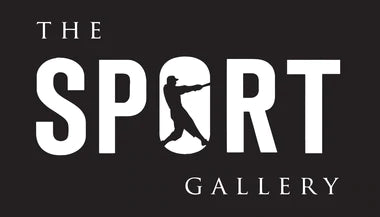This past June I got married in Stanley Park on a rainy Vancouver day. It was a wonderful little ceremony, and in the days following, we did a staycation honeymoon downtown. Because of COVID restrictions I had hardly been out of my own neighbourhood in what felt like years, and so just walking around a busy city centre, even my own, was exciting and new.
I was looking for some sports-related thing downtown to keep as a memento, as I often do on trips. We sought out a vintage shop on one of our walks and there I quickly found an old left-handed baseball glove in the small sports equipment section. I'm a lefty so this immediately peaked my interest. After a quick scan I found a name in the glove's "pocket," that of Pee Wee Reese, a teammate of Jackie Robinson's on the Brooklyn Dodgers.
Harold "Pee Wee" Reese, who earned his nickname playing with small – a.k.a. "pee wee" – marbles as a kid, didn't play baseball until his senior year of high school. He himself was small and thus did not attract much attention with his play. After graduating, Reese spliced cables for the local phone company and played on an amateur church team. Luckily, while in the league final at the minor-league Louisville Colonels' park, he was noticed and soon signed by the Colonels' team owner.
In Reese's second year with Louisville, the Colonels gained a major league affiliate, the Red Sox. He impressed the Sox' owner as well but, with player-manager Joe Cronin wanting that starting shortstop position, Reese was traded to Brooklyn. The Dodgers promoted Reese in his first season with the franchise and he never looked back, eventually moving with the team to Los Angeles for the 1958 season, at the very end of his career.
Reese is best known for his time in Brooklyn; for being their starting shortstop during the glory years, and for being one of the first to welcome and embrace Jackie Robinson publicly after he joined the Dodgers and broke the MLB colour line in 1947. Reese is said to have embraced Robinson on-field in Cincinnati in that first season together, as a display of friendship and acceptance. And while some debate whether this did indeed happen on the field, the pair were good friends.
In 1955, Pee Wee, Jackie, and the Dodgers finally bested the Yankees in the World Series after multiple attempts. Brooklyn celebrated like crazy, but only two years later the Dodgers would be moving westward to L.A. Reese did play the first season there, but only 59 games, and then retired. In his 15 seasons with "Dem Bums" of Brooklyn, the shortstop was an All-Star 10 times.
So, now that we know Pee Wee's story better, let's go back to the glove. As you may have noticed, this glove I found looks a little more modern than the ones from Reese's era; the "fingers" are longer and slimmer, and there's more webbing between the thumb and first finger. Some of the other makings have worn off, but it seems to be a Japanese-made glove from the '60s, possibly by a company called Cambridge. Turns out the glove isn't particularly valuable, or comfortable, really, but it was a mere 10 bucks so I couldn't say no.
There's a name and address on the strap of the glove, which was partly obscured by the price tag at first. Upon getting back to our hotel, I pulled that tag off to reveal: BRYAN ROBERTSON 585 EAST 53RD AVE. VAN, BC. Immediately I know that address is very similar to my childhood home's, which was 535 E 45th. Turns out this guy lived between Fraser and St. George streets just like me, only eight blocks over. A quick google search brings up an obituary under that name, and I see the celebration of life was at Mountainview Cemetery, which is right by my old place. Must be him.
Funnily, I look a lot like Bryan; full face, kind smile, moustache, dark-brown receding hair. From the obituary and the comments left below, it seems he was a great guy. He worked for BC Tel for over 20 years, was an audiophile that drummed in a band, had a memorable laugh, and was a friend to all – a "larger than life" character that left an impression with everyone he met. Sadly, Bryan was diagnosed with early-onset Parkinson's disease in his early 30s. He passed in 2015, much too soon, at the age of 57.
One commenter remembered good times spent at the Burrard Bar, which is very interesting because our staycation hotel was The Burrard; it's an old motel from the '50s that was renovated a few years ago and turned into a vintage-inspired boutique hotel. There very well could have been a bar there back in the day, and if so, Bryan may have spent time in the very same building. What are the odds of that??
I've thought about getting the glove freshened up and broken in by a repair specialist – it would be pretty special to use it for one of my own ballgames. But it does say in the obituary that Bryan was survived by a son, and so my new mission is to get in touch with him; I'm sure he'd love to get a hold of his dad's long-lost glove! That's who it would mean the most to.
So, Tyler, if you're somehow reading this, please know your dad's glove is in safe hands; for now it sits proudly in my office, waiting to be reunited with a Robertson. And if that reunion doesn't happen for whatever reason, know that I will cherish the glove and happily carry on the memory of Pee Wee and Bryan. Two great guys, one special piece of history.
Do you know the Robertson family? Please contact James at jsiddall@thesportgallery.com to get Bryan's glove home!











